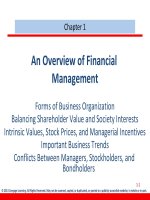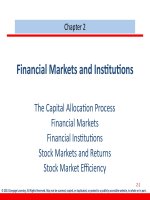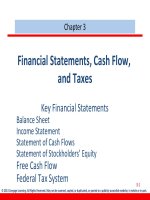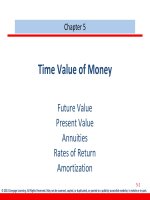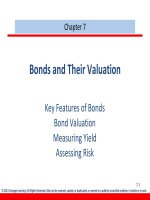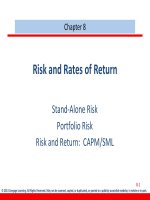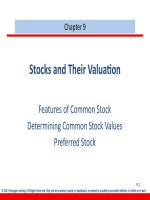Finance management cengage 2013 chapter 06
Bạn đang xem bản rút gọn của tài liệu. Xem và tải ngay bản đầy đủ của tài liệu tại đây (157.56 KB, 22 trang )
Chapter 6
Interest Rates
Cost of Money and Interest Rate Levels
Determinants of Interest Rates
The Term Structure and Yield Curves
Using Yield Curves to Estimate Future
Interest Rates
6-1
© 2013 Cengage Learning. All Rights Reserved. May not be scanned, copied, or duplicated, or posted to a publicly accessible website, in whole or in part.
What four factors affect the level of interest rates?
•
•
•
•
Production opportunities
Time preferences for consumption
Risk
Expected inflation
6-2
© 2013 Cengage Learning. All Rights Reserved. May not be scanned, copied, or duplicated, or posted to a publicly accessible website, in whole or in part.
“Nominal” vs. “Real” Rates
r
= represents any nominal rate
r*
= represents the “real” risk-free rate of
interest. Like a T-bill rate, if there was no
inflation. Typically ranges from 1% to 5% per
year.
rRF
= represents the rate of interest on
Treasury securities.
6-3
© 2013 Cengage Learning. All Rights Reserved. May not be scanned, copied, or duplicated, or posted to a publicly accessible website, in whole or in part.
Determinants of Interest Rates
r = r* + IP + DRP + LP + MRP
r = required return on a debt security
r* = real risk-free rate of interest
IP = inflation premium
DRP = default risk premium
LP = liquidity premium
MRP = maturity risk premium
6-4
© 2013 Cengage Learning. All Rights Reserved. May not be scanned, copied, or duplicated, or posted to a publicly accessible website, in whole or in part.
Premiums Added to r* for Different Types of Debt
IP
S-T Treasury
L-T Treasury
S-T Corporate
L-T Corporate
MRP
DRP
LP
6-5
© 2013 Cengage Learning. All Rights Reserved. May not be scanned, copied, or duplicated, or posted to a publicly accessible website, in whole or in part.
Yield Curve and the Term Structure of Interest Rates
•
Term structure:
relationship between
interest rates (or yields)
and maturities.
•
The yield curve is a graph
of the term structure.
•
The May 2011 Treasury
yield curve is shown at the
right.
Yield Curve for May 2011
6-6
© 2013 Cengage Learning. All Rights Reserved. May not be scanned, copied, or duplicated, or posted to a publicly accessible website, in whole or in part.
Constructing the Yield Curve: Inflation
•
Step 1: Find the average expected inflation rate
over Years 1 to N:
N
IPN =
∑INFL
t =1
t
N
6-7
© 2013 Cengage Learning. All Rights Reserved. May not be scanned, copied, or duplicated, or posted to a publicly accessible website, in whole or in part.
Constructing the Yield Curve: Inflation
Assume inflation is expected to be 5% next year, 6% the
following year, and 8% thereafter.
IP1 = 5% / 1 = 5.00%
IP10 = [5% + 6% + 8%(8)] / 10 = 7.50%
IP20 = [5% + 6% + 8%(18)] / 20 = 7.75%
Must earn these IPs to break even vs. inflation; these
IPs would permit you to earn r* (before taxes).
6-8
© 2013 Cengage Learning. All Rights Reserved. May not be scanned, copied, or duplicated, or posted to a publicly accessible website, in whole or in part.
Constructing the Yield Curve:
Maturity Risk
•
Step 2: Find the appropriate maturity risk premium
(MRP). For this example, the following equation
will be used to find a security’s appropriate
maturity risk premium.
MRPt = 0.1% (t – 1)
6-9
© 2013 Cengage Learning. All Rights Reserved. May not be scanned, copied, or duplicated, or posted to a publicly accessible website, in whole or in part.
Constructing the Yield Curve:
Maturity Risk
Using the given equation:
MRP1 = 0.1% × (1 − 1) = 0.0%
MRP10 = 0.1% × (10 − 1) = 0.9%
MRP20 = 0.1% × (20 − 1) = 1.9%
Notice that since the equation is linear, the maturity
risk premium is increasing as the time to maturity
increases, as it should be.
6-10
© 2013 Cengage Learning. All Rights Reserved. May not be scanned, copied, or duplicated, or posted to a publicly accessible website, in whole or in part.
Add the IPs and MRPs to r* to Find the Appropriate
Nominal Rates
Step 3: Adding the premiums to r*.
rRF, t = r* + IPt + MRPt
Assume r* = 3%,
rRF ,1 = 3% + 5% + 0.0% = 8.0%
rRF ,10 = 3% + 7.5% + 0.9% = 11.4%
rRF ,20 = 3% + 7.75% + 1.9% = 12.65%
6-11
© 2013 Cengage Learning. All Rights Reserved. May not be scanned, copied, or duplicated, or posted to a publicly accessible website, in whole or in part.
Hypothetical Yield Curve
Interest
Rate (%)
15
Maturity risk premium
10
Inflation premium
•
An upward-sloping
yield curve.
•
Upward slope due to
an increase in expected
inflation and increasing
maturity risk premium.
5
Real risk-free rate
0
1
10
Years to
Maturity
20
6-12
© 2013 Cengage Learning. All Rights Reserved. May not be scanned, copied, or duplicated, or posted to a publicly accessible website, in whole or in part.
Relationship Between Treasury Yield Curve and Yield
Curves for Corporate Issues
•
•
•
Corporate yield curves are higher than that of
Treasury securities, though not necessarily parallel
to the Treasury curve.
The spread between corporate and Treasury yield
curves widens as the corporate bond rating
decreases.
Since corporate yields include a default risk
premium (DRP) and a liquidity premium (LP), the
corporate bond yield spread can be calculated as:
Corporate bond
= Corporate bond yield − Treasury bond yield
yield spread
= DRP + LP
6-13
© 2013 Cengage Learning. All Rights Reserved. May not be scanned, copied, or duplicated, or posted to a publicly accessible website, in whole or in part.
Representative Interest Rates on 5-Year Bonds in
May 2011
7-14
© 2013 Cengage Learning. All Rights Reserved. May not be scanned, copied, or duplicated, or posted to a publicly accessible website, in whole or in part.
Illustrating the Relationship Between Corporate and
Treasury Yield Curves
6-15
© 2013 Cengage Learning. All Rights Reserved. May not be scanned, copied, or duplicated, or posted to a publicly accessible website, in whole or in part.
Pure Expectations Theory
•
The pure expectations theory contends that the
shape of the yield curve depends on investors’
expectations about future interest rates.
•
If interest rates are expected to increase, L-T rates
will be higher than S-T rates, and vice-versa. Thus,
the yield curve can slope up, down, or even bow.
6-16
© 2013 Cengage Learning. All Rights Reserved. May not be scanned, copied, or duplicated, or posted to a publicly accessible website, in whole or in part.
Assumptions of Pure Expectations
•
Assumes that the maturity risk premium for
Treasury securities is zero.
•
Long-term rates are an average of current and
future short-term rates.
•
If the pure expectations theory is correct, you can
use the yield curve to “back out” expected future
interest rates.
6-17
© 2013 Cengage Learning. All Rights Reserved. May not be scanned, copied, or duplicated, or posted to a publicly accessible website, in whole or in part.
An Example: Observed Treasury Rates and Pure
Expectations
Maturity
Yield
1 year
6.0%
2 years
6.2
3 years
6.4
4 years
6.5
5 years
6.5
If the pure expectations theory holds, what does the
market expect will be the interest rate on one-year
securities, one year from now? Three-year securities,
two years from now?
6-18
© 2013 Cengage Learning. All Rights Reserved. May not be scanned, copied, or duplicated, or posted to a publicly accessible website, in whole or in part.
One-Year Forward Rate
6.0%
0
x%
1
2
6.2%
(1.062)2 = (1.060) (1 + X)
1.12784/1.060 = (1 + X)
6.4004% = X
•The pure expectations theory says that one-year
securities will yield 6.4004%, one year from now.
•Notice, if an arithmetic average is used, the answer is
still very close. Solve: 6.2% = (6.0% + X)/2, and the
result will be 6.4%.
6-19
© 2013 Cengage Learning. All Rights Reserved. May not be scanned, copied, or duplicated, or posted to a publicly accessible website, in whole or in part.
Three-Year Security, Two Years
from Now
6.2%
0
1
x%
2
3
4
5
6.5%
(1.065)5 = (1.062)2 (1 + X)3
1.37009/1.12784 = (1 + X)3
6.7005% = X
•
The pure expectations theory says that three-year
securities will yield 6.7005%, two years from now.
6-20
© 2013 Cengage Learning. All Rights Reserved. May not be scanned, copied, or duplicated, or posted to a publicly accessible website, in whole or in part.
Conclusions about Pure Expectations
•
Some would argue that the MRP ≠ 0, and hence the
pure expectations theory is incorrect.
•
Most evidence supports the general view that
lenders prefer S-T securities, and view L-T securities
as riskier.
– Thus, investors demand a premium to persuade them
to hold L-T securities (i.e., MRP > 0).
6-21
© 2013 Cengage Learning. All Rights Reserved. May not be scanned, copied, or duplicated, or posted to a publicly accessible website, in whole or in part.
Macroeconomic Factors That Influence Interest Rate
Levels
•
•
•
•
Federal reserve policy
Federal budget deficits or surpluses
International factors
Level of business activity
6-22
© 2013 Cengage Learning. All Rights Reserved. May not be scanned, copied, or duplicated, or posted to a publicly accessible website, in whole or in part.

